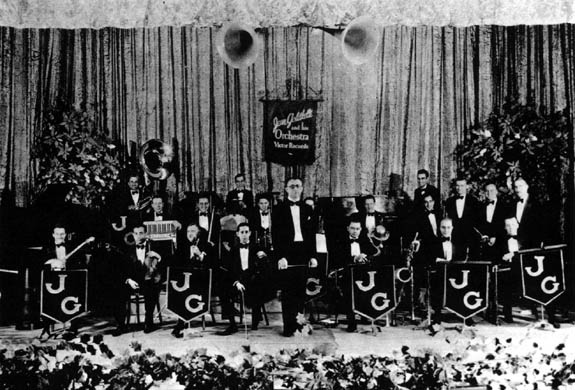After the Depression, swing underwent the changes that most people today recognize as swing music. This was due in no small part to the role played by white bands that are not as well known today as they should be. These bands pushed the envelope among the white audience before Goodman arrived on the scene.
Jean Goldkette was an example. Born in France in 1893 but spending his childhood in both Greece and Russia, John Jean Goldkette emigrated to the U.S. in 1911. Although a classical pianist, Goldkette usually didn’t actually play in his own band preferring to be behind the scenes. He put together some of the greatest jazz musicians of his time in one band including Bix Beiderbecke, Frankie Trumbauer, Eddie Lang, Joe Venuti, Pee Wee Russell, Hoagy Carmichael, Miff Mole, Red Nichols, the Dorseys and arranger Bill Challis. Vocals by the Keller Sisters & Lynch. When Goldkette’s band took up residence in Detroit in the early 20s—in Paradise Valley—he never left and signed a contract with Victor. Fletcher Henderson’s/McKinney’s Cotton Picker trumpeter, Rex Stewart, wrote that Goldkette put together “the first original white swing band in history.” He further wrote of Henderson’s band going up against Goldkette’s: “The facts were that we simply could not compete with Jean Goldkette’s Victor Recording Orchestra. Their arrangements were too imaginative, their rhythm too strong.”
Being in Detroit, Goldkette, in fact, had a hand in helping to organize McKinney’s Cotton Pickers. He was also musical director of the Detroit Athletic Club for over two decades and co-owned the Graystone Ballroom (which I’ve been to many times). He recorded mostly in Detroit and operated out of the Book-Cadillac Hotel (still standing).

The Book-Cadillac Hotel as it looks today showing the Book Tower on the left.

The Jean Goldkette Orchestra

Jean Goldkette
Jean Goldkette - Proud Of A Baby Like You, 1927 - YouTube
The Goldkette band featuring Bix Beiderbecke on trumpet.
In 1927, Goldkette formed the Orange Blossoms in Detroit. In 1929, the Orange Blossoms reformed as a cooperative and elected a bandleader which turned out to be the tall, handsome alto sax player in the band—Glen Gray Knoblauch who simply went by the name of Glen Gray. In October or 1929, the band was ready to record and changed their name to the Casa Loma Orchestra. Their focus was on hot jazz due to the arrangements written by Gene Gifford, the band’s banjoist.
The Casa Loma Orchestra - Dust (1930) - YouTube
The band’s signature number was “The Casa Loma Stomp” which they recorded a number of times for different labels as Victor, Brunswick and Decca. A nice, frenetic swing number with some good bass slapping. The pace of this number was one not many white jazz bands at the time dared to attempt although black bands as the Lunceford orchestra were making a name for themselves with these “flag-wavers.”
The Casa Loma Stomp (Glen Gray and the Casa Loma Orch.) - YouTube
Casa Loma was a hard act for any other band to follow. They were well trained, never got of out sync no matter how fast they went, were never out of tune and allowed much longer solos by certain members than any other band, e.g. baritone sax man Clarence Hutchenrider’s 68-bar solo on “I Got Rhythm.”
78rpm: I Got Rhythm - Glen Gray and the Casa Loma Orchestra, 1933 - Brunswick 6800 - YouTube
This was all before Goodman’s gig at the Palomar. While Fletcher Henderson was a major influence on Goodman, so was Glen Gray and the Casa Loma Orchestra. Goodman was enthralled by the talent of this band out of Detroit so little known today (unless you listen to “40s-on-4” on Sirius/XM radio, then you’ll hear them quite a bit).
Casa Loma offered a modern, updated style of jazz that truly rebelled against white people’s notions of what jazz and white jazz musicians should sound like. Still other early big bands got back to the music’s New Orleans roots. One of these bands was Ben Pollack’s. The Chicago-born self-taught drummer got his start in the New Orleans Rhythm Kings (NORK), a traditional jazz outfit in the early twenties. I can’t find any evidence that he actually played in NORK (he may have sat in) but the band did contain another future early swing bandleader, sax man Jack Pettis. In 1924, Pollack was on the West Coast jamming with an array of musicians. The ones he liked he organized into a band in 1925 and what a band!

Ben Pollack & His Park Central Orchestra in 1926 featuring Glenn Miller and Benny Goodman on the far left. Next to Goodman stands Gil Rodin later to become an executive for MCA. Pollack stands in the center. Harry Goodman stands third from the right.